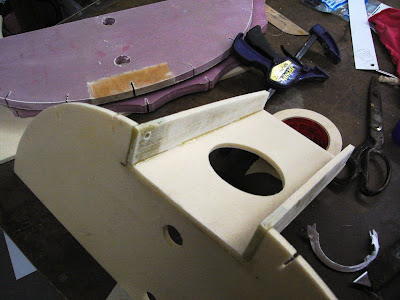 |
| View of the FWD fairing and fuel tank |
The fairing is made up of foam and glass sandwich panels of one ply of 120 style glass and 1/4" PVC foam core. $.5 lb/cu ft density was used. As an alternate, Last-A-Foam urethane foam can also be used. However its been my experience that Last-A-Foam rarely lasts thru shipping. its always coming in cracked. in preparation for the build, a sheet of foam was glassed and allowed to cure.
 |
| Templates used to cut foam board |
 |
| Canopy hinge beams and horizontal shear web |
 |
| adding stringers. |
The Stringers function as fabric stand offs, only the center stringer is a straight line segment. Because of this and the need for the stringers to form to the curvature, the back side is notched. This effectively reduces the thickness of these stringers by the depth of the notch, so they are not adequate to resist the fabric tension. Later an inner "T" cap of 1/4" wide stock will be bonded to the notched edge to restore the stiffness. Excessive stringers are trimmed flush after they cure.
 |
| Finished FWD fairing |
As in the aft Turtle Deck, fabric fairing strips are made from .032" plywood. They are made in "Situ" by first building a poster board template. The outline is traced on to the plywood.
 |
| Another View looking FWD |
The blue fuel lines are for the sight gage mounted on the instrument panel.
No comments:
Post a Comment